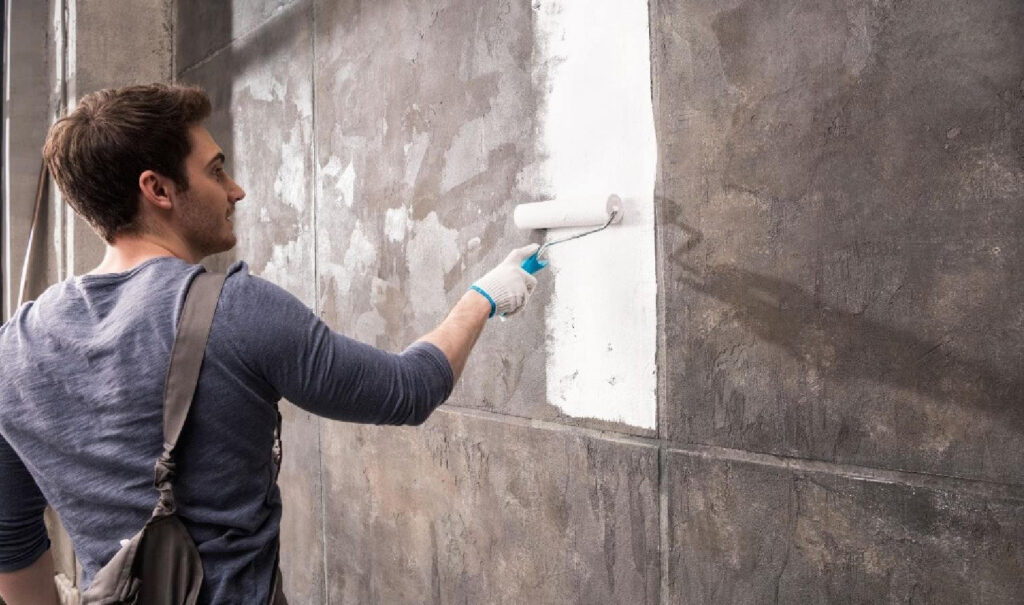Elastomeric paint is a specialized type of coating that offers several benefits to structures. When it dries, it forms a durable and flexible membrane made of polymer resin. It finds application on various surfaces, including concrete, stucco, metal, masonry, wood, and many more. One of the primary benefits of elastomeric paint is its ability to provide soundproofing, water protection, and insulation.
Explanation of Elastomeric Paint
To understand elastomeric paint and its functionality comprehensively, it is crucial to delve into its uses and how it operates. This kind of paint has an elastic quality that allows it to expand and contract with the surface it covers.
This elasticity enables the coating to bridge hairline cracks in walls or roofs that would otherwise allow water penetration. Elastomeric coatings come in different types; some are designed for specific substrates like wood or concrete.
The most common type contains synthetic rubber polymers blended with fillers such as quartz or mica powder. The result is a highly durable film lasting years without cracking or peeling.
Overview of Its Properties
The remarkable properties of this paint make it an excellent solution for several building problems. This coating reflects sunlight, reducing solar heat gain in spaces by deflecting rays from surfaces back into space. This reflective quality creates a barrier between exterior heat sources and interior spaces, effectively insulating against high temperatures. Another way elastomeric paints offer insulation properties involves their thickness; they can add up to 40 mils (1 mm) per coat compared to regular paints’ average coverage of around 10-15 mils.
The thickness of the coating improves thermal resistance, reducing heat transfer through the walls or roofs. This insulation effect can translate into significant energy savings for buildings with higher cooling needs during hot summers. Elastomeric coatings can protect surfaces against water penetration since they create a seamless and waterproof barrier. The elasticity of these coatings allows them to bridge even hairline cracks in walls or roofs. It also prevents water from seeping through and causing damage to the structure.
Additionally, this coating prevents mold formation on surfaces by blocking moisture from penetrating walls or roofs. Elastomeric paint is a versatile solution that offers multiple benefits to building owners.
Its unique properties make it excellent for soundproofing, water protection, and insulation against heat loss and gain. Additionally, as it is long-lasting, this type of paint can help save maintenance costs in the long run by reducing the frequency of building repairs or replacements needed over time.

Soundproofing
The Physics of Sound Waves
Sound waves are vibrations that travel through a medium, like air or solid objects like walls and floors. Sound waves can be absorbed, reflected, or transmitted when facing surfaces. In buildings, sound waves can travel through walls and floors, causing noise pollution that can be disruptive to residents or workers.
How Elastomeric Paint Reduces Noise Pollution
Elastomeric paint is a flexible coating. The paint contains polymers that allow it to stretch and contract with building surfaces as they expand and contract. This flexibility helps the paint create an acoustic barrier that absorbs sound waves instead of reflecting them into the environment.
Benefits of Using Elastomeric Paint for Soundproofing
Elastomeric paint is an effective solution for reducing noise pollution in a wide range of settings. In apartments and condominiums, it can help reduce noise transmission between units by absorbing the sounds of footsteps, voices, and other noises. In music studios and performance spaces, the paint can help prevent unwanted echoes and reverberation by absorbing sound waves before they bounce back off walls and other surfaces.
Overall, elastomeric paint is a versatile solution for reducing building noise pollution. By absorbing sound waves instead of reflecting them into the environment, this paint helps create quieter living spaces for residents while improving working conditions in commercial settings such as music studios.
Water Protection
Water damage is one of the most common and costly problems that building owners and homeowners face. It can come from various sources, like leaky roofs, damaged pipes, or flooding. Water penetrating a building’s walls, ceilings, or floors can cause problems like mold growth, structural damage, and health hazards.
How Elastomeric Paint Can Protect Against Water Damage
Elastomeric paint is an ideal solution for protecting buildings against water intrusion. This type of paint contains a high percentage of solids that create a thick surface coating.
When applied to exterior walls or roofs, it forms a waterproof barrier that prevents rainwater from penetrating the surface. Unlike traditional house paints that may crack or peel over time due to temperature changes or weathering, elastomeric paint is designed to be flexible and stretchy.
This flexibility allows the paint to expand and contract with the building’s movements caused by temperature changes. As a result, it maintains its seal on surfaces without cracking or peeling for many years.
Water Protection with Elastomeric Paint
Elastomeric paint is suitable for any surface that requires protection against water damage. Here are some examples:
- Roofs: Flat and low-sloped roofs are particularly susceptible to water penetration because they tend to accumulate standing water after rainstorms. Applying elastomeric paint on these surfaces can prevent leaks and extend their lifespan.
- Exterior Walls: Buildings in areas with heavy rainfall or high humidity would benefit from elastomeric coatings on their exterior walls. This type of coating not only protects against water intrusion but also helps to reduce energy costs by reflecting sunlight and reducing heat absorption.
- Basements: Basements are often prone to water infiltration, mainly if they are located below ground level. Elastomeric coatings can help prevent mold growth and foundation damage by creating a moisture barrier that keeps water out.
Elastomeric paint is an excellent solution for protecting buildings from water damage. Its waterproofing properties can help reduce the risk of structural damage, health hazards, and costly repairs caused by water intrusion.
Insulation
When it comes to keeping a building comfortable, insulation is vital. Heat transfer can occur in several ways, including conduction, convection, and radiation.
Conduction occurs when heat moves through a solid material, while convection happens when heat is carried by moving air or liquid. Radiation occurs when energy is transferred in the form of waves or particles.
Elastomeric Paint as Insulation
Elastomeric paint can help provide insulation for buildings by reflecting radiant heat away from surfaces. When applied to roofs or exterior walls, the reflective properties of elastomeric paint can reduce the heat that enters the building, making it easier to maintain a comfortable temperature even during hot summer months.
In addition to its reflective properties, elastomeric paint can help fill small gaps and cracks in walls or other surfaces. It reduces air leakage that allows warm air to escape during cooler months. By improving the building’s envelope with elastomeric paint, less energy is required for heating and cooling, resulting in lower utility bills for homeowners.
Insulation with Elastomeric Paint
The benefits of using elastomeric paint as insulation are numerous and varied. Here are just a few examples:
- Attics: applying elastomeric paint on attic roofs can help reflect sunlight away from the house and prevent heat buildup inside the attic space.
- Garages: Many aren’t insulated and can become uncomfortably hot during summer. Using elastomeric paint on garage roofs and exterior walls can provide relief from high temperatures by reflecting sunlight away from these surfaces.
- Metal Buildings: Metal buildings can get hot during the summer, but elastomeric paint can help reflect sunlight and keep the interior cooler. This is particularly useful in commercial or industrial applications where temperature control is essential.
Overall, using elastomeric paint as insulation can be an effective way to improve the comfort and energy efficiency of any building. Its reflective properties and ability to fill gaps and cracks can help reduce energy usage and lower utility bills while keeping occupants comfortable year-round.

Using Elastomeric Paint
Elastomeric paint has proven to be an effective solution for various problems that arise in buildings. The unique formula of elastomeric paint offers excellent soundproofing capabilities by absorbing sound waves and reducing noise pollution.
It is ideal for those living in apartments or near high-traffic areas. Moreover, elastomeric paint has excellent water protection characteristics, making it a perfect coating for exterior walls and roofs.
It acts as a barrier on the wall’s surface preventing water from seeping into the interior. This property is also an excellent choice for structures near water or wet environments.
Elastomeric paint also provides insulation benefits by reflecting heat away from surfaces, which saves energy costs and reduces carbon footprints. With its insulation properties, this paint is ideal for spaces requiring consistent temperature, such as attics.
Versatility and Effectiveness of This Type of Paint
Elastomeric paints offer versatile solutions when it comes to building maintenance solutions. Its unique formula offers many benefits that traditional colors cannot match up to.
Elastomeric paints are available in various colors and textures, making them suitable for any aesthetic preference. Elastomeric paints outlast regular paints, as they resist chipping and peeling, in addition to their other benefits.
Investing in high-quality elastomeric coatings will save you money in the long run and keep your property fresh and well-maintained. With its cost-effectiveness, durability, versatility, energy-saving properties, and many aesthetic options, there’s no reason not to choose Elastomeric Paint as your go-to paint for maintenance and improvements.



























